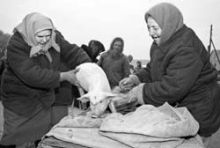The Ukrainian government has introduced licensing for the importation of beef, pork, horned cattle, and pigs in 2006. The Cabinet of Ministers of Ukraine passed a resolution to this effect on Dec. 30, 2005. Experts estimate the annual domestic need for imported meat at 350-400 thousand tons. Meat prices were probably the main cause of last year’s inflation. Now the government is saying that this will not happen. Addressing a group of meat producers late last year, Minister of Agrarian Policies Oleksandr Baranivsky said that in a year’s time Ukraine will have no problems with meat.
The minister claims that this breakthrough will be achieved owing to the new rules of the game in place, now that Ukraine is inevitably approaching membership in the WTO. But in spite of the current WTO debate on canceling farming subsidies, increasing state subsidies for animal husbandry is again the No. 1 question in Ukraine. “The national commodity producer must develop on the European level. Having opened the borders, we cleared the way for imported products to enter our market, but we must also take the next step and support the producer because the EU, whose requirements are being met by import duty, provides huge subsidies for meat,” the minister argued, adding that “we still have miles to go to reach them.”
Aware of the inevitability of Euro-integrative processes, the ministry is nevertheless considering restrictive actions against imported products. According to Viktor Pabat, Deputy Minister of Agrarian Policies, the ministry considers it necessary to replace the current 10 percent import duty on pigs with one that calls for paying at least 0.5 euros per kilo of live weight. He explained that parliament’s decision to cut the import duty on pigs to 5 percent in 2005 led to increased imports, which adversely affected the domestic market. About 140,000 pigs were imported last year. As a result, domestic producers had problems marketing their products.
Baranivsky recalled that last year the Ukrainian meat market suffered a number of serious setbacks: in the spring there was an attempt to import cheap meat, and in the fall the then chief veterinarian of Ukraine allowed the import of 730,000 pigs from abroad. (Oddly enough, the minister says this was done without his knowledge.) Still, this failed to bring down finished product prices, while national meat producers incurred losses to the tune of 78-85 million hryvnias. The market proved viable, however, and the situation was finally rectified.
The national poultry market proved to be no less stable. Even the outbreak of bird flu later in the year did not fundamentally affect it. Although the demand for poultry meat somewhat dwindled in October and November, poultry farmers produced 100,000 tons more meat than in the previous year. Daily consumption of poultry meat also exceeded the 2004 figures.
One of the achievements in 2005, according to Deputy Minister Pabat, was stopping livestock reductions. There was even an upward tendency: the number of cattle increased by 14,000, the number of pigs by 835,000, poultry by 27 million, and sheep and goats by 58,000, compared to the 2004 level. (Since the year was not over, the speaker avoided giving absolute figures.) Yet, there is still a downward trend in the number of cows, which fell by 76,000 on large commercial farms and by 13,000 on private farms. But milk production went up by 30,000 tons.
At the same time, despite the minister’s promise of a problem- free life within one year, the path to meat prosperity looks to be a very long and hard one because Ukraine is still a hopeless outsider in terms of per capita consumption of meat, the main yardstick of efficiency in the meat sector. Things are unlikely to change much in 2006, when the ministry plans to raise the “per head meat ration” from the current 28.5 kg to 42 kg. Citing statistics, the ministry claims that a 1-percent increase in salaries stimulates meat consumption by 0.5 percent. In Pabat’s view, one of the ways to reduce retail prices and increase the demand for meat is to expand the network of companies’ retail outlets. “Still, the main thing is the quality of meat processing and expanding the product range for various population groups,” he says. The worldwide trend is that natural pre-packed meat accounts for 70 percent of total meat consumption.
In keeping with a popular tradition in our governmental departments, the minister could not avoid putting the blame on naysayers. Pabat complained that on six occasions the government has discussed an animal husbandry stabilization program drawn up by experts and academics in this field, but such a program has yet to be adopted. Among those who failed to back the “constitution of animal husbandry” and therefore oppose meat prosperity are the finance and defense ministers and the former minister of economics. Still, it is not enough simply to adopt a doctrine unless it can work at all levels. During a speech by a member at the “grassroots level” a farm manager asked the minister to raise the salaries of district-level agricultural officials. In the speaker’s opinion, this may bring skilled experts into this link of the governmental chain, from whom farmers will be able to obtain real help.







